Couette flow
In fluid dynamics, Couette flow is the flow of a viscous fluid in the space between two surfaces, one of which is moving tangentially relative to the other. The configuration often takes the form of two parallel plates or the gap between two concentric cylinders. The flow is driven by virtue of viscous drag force acting on the fluid, but may additionally be motivated by an applied pressure gradient in the flow direction. The Couette configuration models certain practical problems, like flow in lightly loaded journal bearings, and is often employed in viscometry and to demonstrate approximations of reversibility.[1] This type of flow is named in honor of Maurice Marie Alfred Couette, a Professor of Physics at the French University of Angers in the late 19th century.
Planar Couette flow

Couette flow is frequently used in undergraduate physics and engineering courses to illustrate shear-driven fluid motion. The simplest conceptual configuration finds two infinite, parallel plates separated by a distance . One plate, say the top one, translates with a constant velocity in its own plane. Neglecting pressure gradients, the Navier–Stokes equations simplify to
where is a spatial coordinate normal to the plates and is the velocity distribution. This equation reflects the assumption that the flow is uni-directional. That is, only one of the three velocity components is non-trivial. If y originates at the lower plate, the boundary conditions are and . The exact solution
can be found by integrating twice and solving for the constants using the boundary conditions. A notable aspect of the flow is that shear stress is constant throughout the flow domain.[2] In particular, the first derivative of the velocity, , is constant. (This is implied by the straight-line profile in the figure.) According to Newton's Law of Viscosity (Newtonian fluid), the shear stress is the product of this expression and the (constant) fluid viscosity.
Startup of Couette flow[3][4]
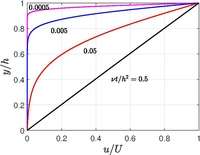
In reality, the Couette solution can't be reached instantaneously. The startup problem is given by
subject to the initial condition
with boundary conditions(same as Couette flow)
The problem can be converted to a homogeneous problem by subtracting steady solution and using separation of variables, the solution is given by
- .
As , the steady Couette solution is recovered. At times , steady Couette solution will be almost reached as shown in the figure. The time required to reach the steady solution depends only on the spacing between the plates and the kinematic viscosity of the fluid, but not on how fast the top plate is moved .
Couette flow with pressure gradient[5]
A more general Couette flow situation arises when a constant pressure gradient is imposed in a direction parallel to the plates. The Navier–Stokes equations, in this case, simplify to
where is fluid viscosity. Integrating the above equation twice and applying the boundary conditions (same as in the case of Couette flow without pressure gradient) to yield the following exact solution
The pressure gradient can be positive (adverse pressure gradient) or negative (favorable pressure gradient). It may be noted that in the limiting case of stationary plates(), the flow is referred to as Plane Poiseuille flow with a symmetric (with reference to the horizontal mid-plane) parabolic velocity profile.
Compressible Plane Couette flow [6]
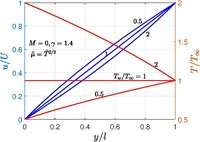
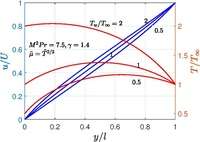
This problem was first addressed by C.R. Illingworth[7] in 1950. In incompressible flow, the velocity profile is linear because the fluid temperature is constant. When the upper and lower walls are maintained at different temperatures, the velocity profile is complicated, but it turns out it has an exact implicit solution. Consider the plane Couette flow with lower wall at rest and properties denoted with suffix and let the upper wall move with constant velocity with properties denoted with suffix . The properties and the pressure at the upper wall are prescribed and taken as reference quantities. Let be the distance between the two walls. The boundary conditions are
where is the specific enthalpy and is the specific heat. Conservation of mass and momentum reveals that everywhere in the flow domain. Conservation of momentum and energy reduce to
where is the wall shear stress, but the whole flow domain takes the same shear stress similar to the incompressible Couette flow. The flow do not depend on the Reynolds number , but rather on the Prandtl number and the Mach number , where is the thermal conductivity, is the Speed of sound and is the Specific heat ratio. It turns out that the said problem can solved implicitly. Introduce the non-dimensional variables
Therefore, the solutions are
is the heat transferred per unit time per unit area from the lower wall. Thus are implicit functions of . It is useful to write the solution in terms of recovery temperature and recovery enthalpy as the temperature of an insulated wall i.e., the value of for which . Then the solution is
If specific heat is assumed constant, then . When and , then and are constant everywhere, thus recovering the incompressible Couette flow solution. Except this case, one should know to solve the problem. When and , the recovery quantities become unity . There are number of laws to predict for example Sutherland's formula, power law etc. For air, the values of are commonly used and the results for this case is shown in figure.
Liepmann[8][9] studied the effects of dissociation and ionization (i.e. is not constant) and showed that the recovery temperature is reduced by the dissociation of molecules and also he studied the hydromagnetics[10] effects on this compressible Couette flow.
Couette flow in rectangular channel
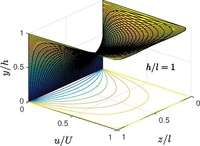
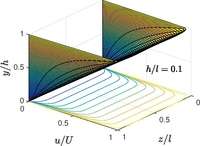
One-dimensional flow is valid when both plates are infinitely long in streamwise and spanwise direction. When the spanwise length is made finite, the flow becomes two-dimensional . The infinitely long length in streamwise direction still needs to be held to ensure the uni-directional nature of the flow.
The below problem is due to Rowell and Finlayson (1928).[11] Consider an infinitely long rectangular channel with transverse height and spanwise width , subjected to the condition that the top wall moves with a constant velocity . Without any imposed pressure gradient, the Navier-Stokes equations reduce to
with boundary conditions
Using Separation of variables, the solution is given by
When , the classical plane Couette is recovered as shown in the figure.
Couette flow between coaxial cylinders [12]
Couette flow between coaxial cylinders also known as Taylor-Couette flow is a flow created between two rotating infinitely long co-axial cylinders. The original problem was solved by Stokes in 1845,[13] but Geoffrey Ingram Taylor name was attached to the flow because he studied the stability of the flow in his famous paper[14] in 1923. If the inner cylinder with radii rotating at a constant angular velocity and the outer cylinder with radii rotating at a constant angular velocity , then the velocity in direction is given by
(Note that r has replaced y in this result to reflect cylindrical rather than rectangular coordinates). It is clear from this equation that curvature effects no longer allow for constant shear in the flow domain, as shown above.
Couette flow between coaxial cylinders of finite length
The classical Taylor-Couette flow problem assumes infinitely long cylinders, but the finite length effects which are encountered in real life are more pronounced in cylindrical geometry. The flow is still unidirectional and the solution for with cylinder length using separation of variables or using integral transforms is given by[15]
where are Modified Bessel function of the first kind and Modified Bessel function of the second kind respectively.
See also
- Hagen–Poiseuille equation
- Taylor–Couette flow
- Hagen–Poiseuille flow from the Navier–Stokes equations
References
- ↑ J. P. Heller (1960) "An unmixing demonstration" American Journal of Physics 28, 348-353.
- ↑ Kundu P and Cohen I. Fluid Mechanics.
- ↑ Batchelor, George Keith. An introduction to fluid dynamics. Cambridge university press, 2000.
- ↑ Acheson, David J. Elementary fluid dynamics. Oxford University Press, 1990.
- ↑ George Keith Batchelor, . An introduction to fluid dynamics. Cambridge university press, 2000.
- ↑ Paco Lagerstrom. Laminar flow theory. Princeton University Press, 1996.
- ↑ Illingworth, C. R. "Some solutions of the equations of flow of a viscous compressible fluid." Mathematical Proceedings of the Cambridge Philosophical Society. Vol. 46. No. 03. Cambridge University Press, 1950.
- ↑ Liepmann, Hans Wolfgang, and Anatol Roshko. Elements of gasdynamics. Courier Corporation, 1957.
- ↑ Liepmann, H. W., and Z. O. Bleviss. "The effects of dissociation and ionization on compressible couette flow." Douglas Aircraft Co. Rept. SM-19831 130 (1956).
- ↑ Liepmann, H. W. "Hydromagnetic effects in Couette and Stokes flow." The Plasma in a Magnetic Field: A Symposium. Stanford University Press, 1958.
- ↑ Rowell, H. S. "u. D. Finlayson." Engineering 17, 606 (1922) 23 (1928): 249.
- ↑ Lev Landau and E. M. Lifshitz. "Fluid Mechanics Pergamon." New York 61 (1959).
- ↑ G.G. Stokes(1845) ``On the theories of the internal friction of fluids in motion and of the equilibrium and motion of elastic solids, in Mathematical and Physical Papers, pp. 102-104, Cambridge, UK: Cambridge University Press, 1880.
- ↑ G.I. Taylor (1923) Stability of a Viscous Liquid Contained between Two Rotating Cylinders, Philosophical Transactions of the Royal Society of London. Series A 223, 289–343.
- ↑ Wendl, Michael C. "General solution for the Couette flow profile." Physical Review E 60.5 (1999): 6192.
- Richard Feynman (1964) The Feynman Lectures on Physics: Mainly Electromagnetism and Matter, § 41–6 "Couette flow", Addison–Wesley ISBN 0-201-02117-X .